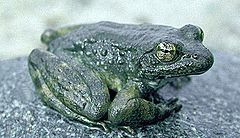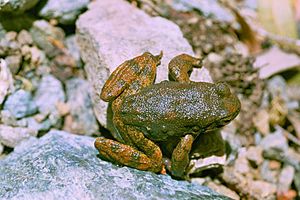Foothill yellow-legged frog facts for kids
Quick facts for kids Foothill yellow-legged frog |
|
|---|---|
 |
|
| Conservation status | |
| Scientific classification | |
| Kingdom: | |
| Phylum: | |
| Class: | |
| Order: | |
| Family: | |
| Genus: | |
| Species: |
R. boylii
|
| Binomial name | |
| Rana boylii Baird, 1854
|
|
The Foothill Yellow-legged Frog (Rana boylii) is a small frog, usually between 3.7 and 8.2 centimeters long. It belongs to the Rana genus, which includes many true frogs. You can find this frog along the west coast of North America, from northern Oregon down through California and into Baja California, Mexico. Other frogs like the Columbia Spotted Frog and the Cascades Frog also live in the northern parts of its home range. These frogs love living in streams and rivers. They lay their eggs in groups, sticking them to rocks underwater. The eggs can hatch in 5 to 30 days, depending on how warm the water is.
Contents
What They Look Like
The Foothill Yellow-legged Frog has a back, or dorsum, that can be grey, brown, or reddish. It often has spots or a mottled pattern, but sometimes it's plain. Adult frogs have yellow coloring under their legs, which might spread to their belly. Young frogs usually don't have this yellow color. They have a light, triangular patch on their snout. Unlike some other Rana frogs, they don't have a stripe near their eyes. Their throat and chest often have bold spots. Their skin is a bit rough, and they have faint skin folds along their sides. During mating season, male frogs grow a special pad on their thumb base.
You can tell these frogs apart by their rough skin, horizontal eye pupils, and fully webbed back feet. They also tend to jump into moving water when scared. Young Foothill Yellow-legged Frog tadpoles look similar to Western Toad tadpoles. However, R. boylii tadpoles have flatter tails that are colorless at the end and are tallest in the middle. Their mouths are shaped to suction onto rocks. They have rows of tiny teeth, called labial teeth, which they use to scrape algae and diatoms (tiny water plants) off rocks. After about three weeks, young Foothill Yellow-legged Frogs develop more defined tooth rows, which helps tell them apart from Western Toad tadpoles.
What They Eat
The food that tadpoles eat affects how well they grow and become strong enough to reproduce. For example, the amount of protein in different types of algae can change how big tadpoles get and how long it takes them to transform into frogs. This is because food can affect their thyroid gland, which controls growth. Tadpoles mostly eat algae, diatoms, and tiny bits of decaying matter.
As the frogs grow older, their diet changes to animal tissue. Adult frogs swallow their food whole because their jaw can only move up and down, not sideways like ours. They eat many different insects and small creatures. This includes moths, ants, grasshoppers, hornets, beetles, flies, water striders, and snails.
Life Cycle and Reproduction
Mating season for these frogs starts in spring. Adult frogs gather on sandy or rocky riverbanks to mate. It was once thought they mated from March to May, but now we know it's usually from April to late June. These frogs are careful about where they lay their eggs. Fast-moving water can wash away egg masses. So, R. boylii avoids strong currents to protect their eggs. This is why they have a long breeding season. If the water conditions aren't just right, they will wait until the currents slow down to an ideal speed before mating.
Male frogs mostly make mating calls underwater. The calls they make above water are very quiet and hard to hear from far away. After mating, the egg masses are placed about half a meter deep in the river. The water flow where they lay eggs is usually gentle. Each egg mass can contain anywhere from 100 to 1000 eggs. The eggs are held in a bluish gel that disappears as the eggs absorb water. The dark center of each egg is covered by three jelly layers, each about 5.4 millimeters wide.
Eggs hatch in about 5 to over 30 days, depending on the water temperature. The tadpoles stay near the egg mass for several days. They need warmer temperatures to grow quickly. By the time tadpoles reach about 40 millimeters (about 1.5 inches), they are adult frogs. Their reproductive organs are mostly ready to work. Most frogs are fully grown by the first summer after their transformation, but some can start breeding after just six months.
Where They Live
The Foothill Yellow-legged Frog lives in a wide area. Their home stretches from northern Oregon, down California's coast (where they are most common), and into Baja California, Mexico. They prefer streams and rivers over still ponds. They choose flowing water with either rocky bottoms or sunny banks. They also like rivers and streams that have shallow areas where the water still moves.
How They Defend Themselves
These frogs have a special ability to protect themselves from fungi. They have parts of a protein, called a peptide, that repel water. This helps block fungi from attaching to their skin. Other Rana species, like the Cascades Frog and the Moor Frog, also have similar defenses. The Cascades Frog releases a milky substance to fight fungal infections. The Moor Frog males turn blue during mating season, which is also a defense.
Scientists are still studying the Foothill Yellow-legged Frog's chemical defense. This ability has interested companies that make anti-fungal creams because it is very effective. However, pesticides used by humans can cause problems for these frogs. Studies show that even if a pesticide called carbaryl doesn't kill the frogs, it can weaken their ability to fight off invaders like the chytrid fungus. More research is being done to understand the full effects of pesticides on R. boylii.
Environmental Challenges
Besides problems with pesticides, dams also affect the Foothill Yellow-legged Frog. In Trinity County, California, a dam on a major river has changed about 94% of the possible breeding areas for these frogs. This has greatly affected their population.
Who Eats Them
The Foothill Yellow-legged Frog is a meal for many animals. These include diving beetles, water bugs, garter snakes, rough-skinned newts, bullfrogs, and native toads like the Western Toad.
See also
 In Spanish: Rana boylii para niños
In Spanish: Rana boylii para niños





